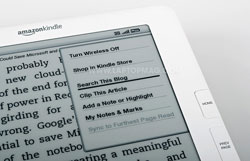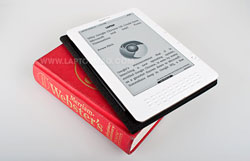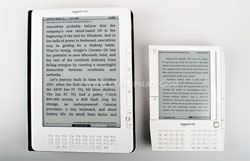Laptop Mag Verdict
The larger Kindle DX is a well rounded e-book optimized for reading textbooks and newspapers, but we wish it were less expensive.
Pros
- +
Expanded, crisp E-Ink display
- +
Accelerometer for adjusting screen orientation
- +
Expanded storage
- +
Fast wireless downloads
Cons
- -
Expensive
- -
Bulkier than the Kindle 2
- -
Some popular books not available
- -
Battery not user-replaceable
Why you can trust Laptop Mag
Editors' Note: Portions of this review were taken from our earlier review of the Kindle 2.
As it turns out, one size does not fit all when it comes to digital reading devices; at least that's Amazon's attitude. Just two months after releasing its slimmer, 5.4-inchKindle 2, the company has released the larger 9.7-inch Kindle DX. Optimized for reading larger-paged textbooks and newspapers, the Kindle DX (which stands for Deluxe) not only has a larger screen, but twice the amount of storage, and an accelerometer that quickly switches to landscape mode. Still offering lightning-fast wireless downloads for thousands of available titles, a text-to-speech feature, and a design that's thinner than the iPhone 3G, the Kindle DX is a well rounded e-book reader. However, $489 is a lot to ask when you can get a budget laptop for the same price, or the smaller Kindle 2 for almost $200 less. Still, the Kindle DX is worth the splurge for those looking for an e-book reader with a larger display.
Design
While the Kindle DX has the same design as the Kindle 2, it's larger and heavier. At 10.4 x 7.2 inches, the Kindle DX has almost the same footprint as a magazine, and is 2.4 inches wider and 1.9 inches longer than the Kindle 2, which makes it a struggle to fit into a purse. However, at 0.38 inches thick, the DX is only 0.02 inches thicker than the Kindle 2, and almost twice as thin as the originalKindle. At 18.9 ounces (8.7 ounces more than the Kindle 2) the DX is on the heavier side, though not too pudgy for holding upright during long reading stints.
The brushed-aluminum back of the DX, contrasted with its white face, makes it look like an Apple-designed product--which is a compliment. In our hands, it felt more like a premium slate than an awkward, plastic device like the original Kindle. The back of the DX does not detach; there is no removable battery or memory card slot like the original--though Amazon says this version can hold more than 3,500 books.
Buttons and Keyboard
As with the Kindle 2, the Next and Previous Page buttons are located on the left edge, and are inward-facing to prevent the accidental page-turning issue that was prevalent on the first Kindle. The Home button gives quick access to the home screen, instead of having to search for the small Home icon on the keyboard. Two stereo speakers now sit on the rear of the device, and a 3.5mm headphone jack is at the top.
Sign up to receive The Snapshot, a free special dispatch from Laptop Mag, in your inbox.
The scroll wheel has been replaced by a stiff but usable five-way controller. We preferred the scroll wheel on the first Kindle for quickly scrolling through pages instead of having to push down repeatedly, but the new controller allows for more precise movement. You can also use it to highlight text and look up words.
The QWERTY keyboard on the DX is different from that on the Kindle 2. The white oval keys remind us of Tylenol capsules, and are comfortable for creating notes, searches, and entering Web addresses, but we prefer the rounder buttons on the Kindle 2, as they fit our fingers better.
Click to enlarge
Display
Text, like that on the Kindle 2, is noticeably crisper than the original, and the DX's larger 9.7-inch screen with a 1200 x 824-pixel resolution provides more real estate for reading. If you looked closely at the original Kindle, you could make out lots of tiny flecks, and the screen almost had a smudged look to it. The Kindle DX has the same gray background, but the smudging is gone; images appear much sharper. The 16 levels of grayscale add a lot of detail to pictures. For example, the front page of The New York Times looks much more photorealistic, rather than a sketch made with a graphite pencil.
Not only does the screen accommodate larger pages and images, but, unlike the Kindle 2, the Kindle DX has a built-in accelerometer for viewing pages in landscape mode. Like the iPhone, simply turning the device on its side reorients the screen. The screen was quick to adjust, taking about one second to go from horizontal to vertical viewing and visa versa. You can manually adjust the orientation of the screen by clicking the Aa button, which is also used to change the size of the text.
Reading on the Kindle DX over a long weekend was a pleasure. The display doesn't induce headaches or eyesores like a computer monitor would; text is crisp yet soft enough to remind us of a page in a book. Though it's barely noticeable, the screen still flickers. Pages turn in less than a second, which Amazon claims is 20 percent faster than the original Kindle. Reading by the pool was pleasant, and there was absolutely no glare caused by the sun. However, when it came to reading at night in our bed, we wished there was a built-in backlight.
Content Selection and Whispernet
Click to enlargeThere are more than 300,000 books available (up from 90,000 when the first model launched) for the Kindle DX, including 107 of the 112 New York Times' Best Sellers. Some hugely popular books, like the Harry Potter series, are still missing, as are some titles from authors such as John Updike. Books range in price, but new releases are typically $9.99.
The Kindle DX, like the Kindle 2, runs on Sprint's 3G EV-DO network, called Whispernet, which means you don't need a PC to load it up with content. The integrated Internet connection enables users to download books on the go, even in places with no Wi-Fi coverage--like on a train, for example.
You can manage your Kindle DX remotely by logging into www.amazon.com/manageyourkindle. Here you can add subscriptions, resend books to your device, or transfer them from one Kindle to another. Amazon's Whispersync automatically synchronizes content between several Kindles, or even an iPhone (via the free app); if you're reading a book on the Kindle DX, the last page read on that device will be the first page that appears when you open the Kindle app on the iPhone.
We fired up the Kindle and bought a copy of Hugh MacLeod's Ignore Everybody and Steven Colbert's I Am America--And So Can You. Both books took only 15 seconds to download. Everything you purchase is sent to the main home screen, which lists the books you have available on the device.
While reading, a bar at the bottom of the page indicates just how far along you are in the book. If you click Menu, you can choose to turn off wireless to save battery life, shop in the Kindle store, view the cover, or jump to the table of contents. You can jump to the beginning of the book or a specific location, bookmark a page, add a note, highlight a passage, or read a description of the book. These items appear under the My Clippings section, which you can access from the home screen. The notes and clippings are tagged with the date you read the book and the time you made the note.
Blogs, Magazines, and Newspapers
The Kindle DX's larger display has been optimized to make reading newspapers more enjoyable (which is one of the reasons the company has partnered with The New York Times and other newspapers to provide subsidized devices to certain subscribers). You can also subscribe to magazines, newspapers, and blogs for a monthly fee.
Currently, 32 magazines are available; you can purchase single issues or pay for a subscription. Subscriptions cost anywhere from $1.25 to $10.49 per month. A single issue of The New Yorker costs $1.99, while others, like Newsweek, are just 49 cents. A subscription to The New Yorker will set you back $2.99 per month, while Newsweek costs $1.49 per month.
The 43 newspapers available are sorted by country (U.S., China, France, Germany, Ireland, and the United Kingdom; the International Herald Tribune is also available under "International"). As with the magazine option, you can choose to buy a single issue or a subscription; subscriptions range in price between $5.99 and $14.99 per month. The New York Times, for example, costs 75 cents for a single issue, or $13.99 per month. The Wall Street Journal costs 99 cents, and a monthly subscription is $14.99. If you purchase a subscription, new editions are sent automatically overnight, or whenever you reactivate Whispernet.
When we downloaded The New York Times, we were pleased to see that ads are not included. The list of sections, which included Arts, International, and National, was convenient; it let us skip around the paper efficiently. Clicking the Next Page button each time we wanted to read further down the page felt a bit disorienting at first.
Blog subscriptions start at 99 cents, and there are currently 6,140 blogs to choose from. The Amazon store doesn't let you subscribe to blogs for free--as you would with an RSS feed on your phone--so you may want to take advantage of the free Web browser for accessing your favorites where an EV-DO connection is available. We subscribed to LAPTOP Magazine's blog for $1.99 per month (a free 14-day trial is included). Once you've subscribed to a blog, the title shows up on your home screen; click it to display the first post. Selecting View Articles List below the post brings up a list of the latest articles published by that blog. You can't view videos on the Kindle DX.
Integrated Dictionary and Notes
Click to enlargeIf you hover over a word while you're reading, the KindleDX automatically searches for it in The New Oxford American Dictionary (which includes more than 250,000 definitions) and displays the definition at the bottom of the screen almost instantly. To view a larger definition of a specific word, press the Enter key on the keyboard; press the Back key to return to the text. This feature is handy and minimizes distractions while reading.
Text-to-Speech
The Kindle 2's Text-to-Speech feature is also included on the DX, and reads the text on any page out loud to you either through the speakers or through the top-mounted 3.5mm headphone jack. The idea is that this function could let you enjoy content when you have your hands full, say, while driving.
You can choose between a male or female voice by selecting the Aa key. Choose from three speed options: slower, default, and faster. Default sounds the most normal; "slower" sounded like the voice is speaking underwater; and "faster" sounds too jumbled.
Overall, the voice feature sounded too robotic. When using this feature for reading a book, the emotion and context of the story is utterly lost. Text-to-Speech didn't work very well in a fairly dry New York Times article about the economy, either. The pace of the voice seemed inconsistent; it spoke some words quickly and others slowly, so sentences sound like words strung together out of context.
Web Browsing and Music
Clicking Menu on the home screen and selecting Experimental will bring you to a page of experimental services, which includes the aforementioned Text-to-Speech reader as well as an MP3 player and a free Web browser. We loaded the text-only, mobile-friendly CNN News page in about 9 seconds and appreciated the basic linear formatting. As with digital newspapers, though, to scroll farther down the page you have to hit Next Page instead of just scrolling down. The multimedia-heavy NationalGeographic.com homepage loaded incorrectly, but included links for the main story categories. The Kindle DX isn't meant to be a Web-browsing device, however, so we'll forgive its mediocrity.
If you like the idea of listening to music while you read or hearing a real audio book, the Kindle DX makes transferring songs to the device relatively simple. Unplug one end of the Kindle DX cable from its small power adapter and plug it into your PC. We transferred two Meiko tracks over to the device and played them back using the MP3 player. Audio sounded much better than we expected: Music played loud and clear through the Kindle DX's two speakers.
Documents
Amazon assigns each Kindle DX a dedicated e-mail address, so you can send Word, TXT, HTML, or PDF files to it. Amazon charges 10 cents for each conversion if you decide to have it sent to the Kindle DX over Whispernet; there's no charge if you drag and drop files on the device from your computer. The built-in PDF reader let us to open our PDF files right from the main menu (the Kindle 2 requires the PDF to be converted).
Accessories
Click to enlargeOur review unit came with Amazon's leather cover, which costs $49.99. Still, we highly recommend getting one, since the display may get bumped around or scratched by keys inside a purse or backpack. The leather cover was very attractive, and the hinge locks tightly. If you press a small button on the hinge, it will release the device from the cover.
Battery Life
With a full charge, Amazon claims the Kindle DX will last 4 days with wireless turned on. With EV-DO off, however, the Kindle DX should last more than 2 weeks. We will update this review after we've tested those claims, but we can confirm that after many hours, including a weekend of use, the battery meter didn't budge. Unfortunately, the battery cannot be removed by the user and must be replaced by Amazon.
Pricing
The Kindle DX costs $489, as opposed to the Kindle 2's price of $299. With the Kindle DX, however, Amazon is exploring different purchase methods. The Washington Post, The New York Times, and The Boston Globe will offer the DX at a discount to readers who live outside of each paper's circulation area and subscribe to their respective Kindle editions. And five schools, including Arizona State University, Case Western Reserve University, and Princeton University will provide the device to students to use as textbook readers. While these unique groups will get around the high price of the DX, the question remains as to whether or not nearly $500 is a worthwhile investment to the average reader.
Most best-seller books are $9.99 each; if you read 10 hardcover books a year, at roughly $17 each, then you would spend $170 on books. Those same ten books would cost you $99 on the Kindle. At that rate, you would save $71 per year with the Kindle DX, but it would take almost 5 years to make up the cost of the Kindle DX itself. But that's just if you're reading books.
If you were to subscribe to The New Yorker as well, which costs $39.95 per year in print or $35.88 per year with the Kindle, then you're saving both a few bucks and the environment. If you tack on a New York Times subscription to your monthly Kindle DX bill, then you'll be paying $167 per year, compared to $531 for a print subscription. (However, you won't get bonus features like the crossword.)
Over time, you'll certainly save money using the Kindle DX, especially if you do more than read books, but the true value of the device lies in having all this content available in a single, lightweight device. However, it will be hard for some to overlook the value of having hard copies of content to share with friends and family.
Verdict
The Kindle DX's hardware, like the Kindle 2, is a welcome update, and its larger screen, built-in accelerometer, and added storage space all sweeten the deal. However, its price of $489 is hard to swallow. Those seeking an e-book reader that can fit into a purse or small bag would do best to save $200 and go with Amazon's Kindle 2. But those looking for a larger display and larger images--and don't mind the extra weight--would be well served with the Kindle DX.
Amazon Kindle DX Specs
| Company Website | http://www.amazon.com |
Joanna Stern was a laptop reviewer and writer at Laptop Mag. She reviewed notebooks big and small, including models from MSI, Asus, Toshiba, and Lenovo. This was right at the beginning of her impressive career in journalism. Since then, she's become one of the most recognizable voices in consumer tech. Joanna now works with The Wall Street Journal, and was previously a founding editor at The Verge. After Laptop Mag, she worked at Engadget as a reviews editor. Joanna has won a News & Documentary Emmy Award as well as two Gerald Loeb Awards.




